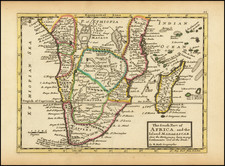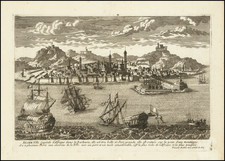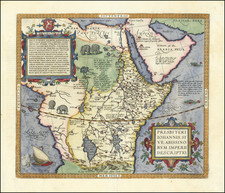Maps of the First Successful Anglo-Egyptian Colonial Effort To Create Large Scale Hairs in Sudan
Remarkable large set of maps, illustrating the creation of Hafirs (a traditional system for retention of rain water) in Sudan circa 1950-51, undertaken by the British Colonial authorities. The project was a combined effort between the colonial authorities and the Cotton industry, Sudan's major agricultural export.
The maps were compiled by the Ministry of Agriculture, as part of the improvement of surface water retention systems. As described by J.H.K Jefferson in his report in 1954:
THE OUTLINE OF THE PROBLEM
About one-third of the area of the Anglo-Egyptian Sudan—or some 300,000 square miles . . . withholds its potential of pastoral and agricultural wealth for the primary reason of shortage of drinking water. . . .
Were the 300,000 square miles unbroken plain, little development by surface water supply would be possible because the rainwater would be absorbed where it fell; but the plain is broken at wide intervals in the east and centre by inselbergs and in the west by weathered sand dunes. Exploitable water catchments are formed by the inselbergs and their plinths and by the clay-sand mixtures formed round the sand dunes by the washing out of their clay fraction by rainwater. Natural catchments give rise to scanty water supplies that support some permanent and many seasonal settlements over the large areas lacking underground aquifers. . .
Existing water supplies allow the use of three per cent or less of the agricultural land and the pastoral land to be used at a low efficiency. Until just after the second world war practically the entire effort to improve water supplies was devoted to tapping underground sources. . . No large-scale effort to exploit surface storage methods was possible, because the heavy earth-moving equipment needed was only developed in America just before the war started. Towards the end of the war there arose a determination among those responsible for the welfare of the Sudan to attempt the development of the rainlands, partly for their own sake and partly to broaden the basis of the country's economy by farming "which did not have cotton as its mainstay. Cotton had always been the main revenue producer and the fear . . . that it would one day be supplanted by something else and leave the coffers empty, inspired the venture into the rainlands, a venture which is still not proven but lies in the realms of promise.
EARLY WORK
The noun 'Hafir ' is the Arabic word for a hole in the ground excavated for the storage of rainwater. Hand dug hafirs have been used in the clay plains of the Sudan probably from time immemorial. . . . Hafirs are the obvious means of water storage in areas of impervious clay without underground aquifers. It seems that the majority of the old hafirs were dug in an era of greater rainfall when the flooding of the land by rainstorms was a regular occurrence . . .
In 1946 six Caterpillar D7 tractors and six Le Torneau 11 cubic yard scrapers . . . were procured by the then Department of Agriculture, through the para-military organization the Middle East Supply Corporation, for the purpose of mechanical hafir excavation. Though they had not been tried for this specific purpose Dr. J. Smith, then Deputy Director of Agriculture, was convinced that they would work. The machines were based upon workshops at Wad el Huri near Gedaref, started a few years earlier for other lines of rainland development, which were expanded to deal with servicing problems. . . .
Before leaving the subject of hafirs used for stock mention must be made of successful and important operation carried out in the 1950-51 and 1951-52 seasons. This consisted of the provision of water by hafirs along 300 miles of a 600 mile route from stock raising country in the south-western Sudan to a new canning factory recently erected by Messrs. Liebig at Kosti on the White Nile. It was intended to have hafirs on the route at 15 mile intervals, which was considered by the veterinary authorities to be the best spacing, but lack of time for reconnaissance resulted in an average interval of about 30 miles. The hafirs are of 25,000 cubic metres capacity each and are dug as twins of equal capacity. The object of this is to facilitate desilting when it becomes necessary, as one half may be pumped into the other when the levels have dropped sufficiently and clearance work carried out without leaving the point waterless. The two halves were dug in successive seasons, and a strong supporting reason for this action at the time was the very high price of cotton grown in the area of Kordofan Province south of the hafirs. This enabled a considerable extra capacity of hafirs to be given immediately to the cotton industry, which has paid quick dividends. In addition to the hafirs along this route it is hoped to make a group near Kosti which will enable cattle to stay in a holding area to act as a reservoir of animals and stabilize the flow to the factory.
Map #1 - 1951-52 Season (unsigned)
Map of Part of Kordofan and Blue Nile Provinces Showing:
- New Hafirs to be dug by either Excavation Team
- Proposed Route of Teams
- Roads Requiring Grading
- Roads Requiring Degrassing
- Relevant Previously Dug (Mechanically) Hafirs
- Cleared Tracks, non graded
Map #2 - Signed by J.H.K. Jeffeson Soils Conservation Officer 27.7.1951
Part of Blue Nile and Upper Nile Provinces Showing:
- Roads Requiring Grading
- Roads Requiring Re-Grading
- Roads Requiring De-Grassing
- Relevant Previously Dug (Mechanically) Hafirs
- Sites To Be Surveyed For New Hafirs
Map #3 - Projected by J.H.K. Jefferson / Drawn by A. Shora / Date: 25.7.1950
Kordofan Province Appendix A Showing Roads & Hafirs To Be Made in Kordofan in the 1950/51 Season
- Existing Graded Road
- To be graded against Nuba Mountains Cotton Accounts
- To be graded against R.W.S. & S.C. Fund
- Hafir access roads to be prepared by Inspector of Agriculture
- Existing non graded main road
- Faint broad white arrows suggest route of team
- Hafirs
- Route of Road Team (12.8 kilos per day)
Map #4 - Projected by J.H.K. Jefferson / Drawn by A. Shora / Date: 25.7.1950
Blue and Upper Nile Provinces Appendix B Showing Roads & Hafirs To Be Made in Kordofan in the 1950/51 Season
- Existing Graded Road
- Road Graded by R.W.S. & S.C. Fund
- Hafir access roads to be prepared by Inspector of Agriculture or relevant beneficiary
- Existing non graded main road
- Faint broad white arrows suggest route ofteam
- Haifrs - site fixed
- Hafirs - stie to be fixed
- Kordofan Hairs
At the time we purchased the maps, we were told that they had come from the collection of the first automobile dealership in Khartoum.
Image #1-76 x 69
Image #2-45 x 69.5
Image#3-29 x 36.5
Image#4- 29 x 37.5











![[ Africa. ] Tabula IIII. Aphricae. Hae Sunt E Cognitis Totius Orbis . . . (title on verso)](https://storage.googleapis.com/raremaps/img/small/103154.jpg)


![(North Africa) Barbaria [Barbary]](https://storage.googleapis.com/raremaps/img/small/97498.jpg)

![Tabula Aphricae II [shows Sicily and Sardinia]](https://storage.googleapis.com/raremaps/img/small/47363.jpg)